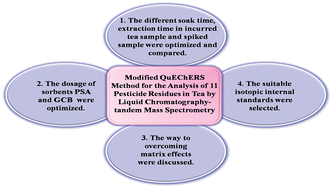Modified QuEChERS method for the analysis of 11 pesticide residues in tea by liquid chromatography–tandem mass spectrometry
Abstract
An accurate, rapid and reliable method for the simultaneous determination of 11 pesticide residues in tea by liquid chromatography–electrospray ionization tandem mass spectrometry has been established. Samples were purified by a modified QuEChERS method, followed by analysis by LC–ESI(+)-MS/MS and quantification using isotope internal standards. In this study, different extraction conditions, such as soaking time, extraction time of pesticides from the real tea samples and spiked samples, were optimized and compared. It was found that pesticides in real tea needed more time to be soaked and extracted than those in spiked tea for complete extraction. In order to eliminate the matrix effect and obtain satisfactory recoveries, the dosage of sorbents PSA (125, 250, 400, 600, 800, 1000, 1200 mg) and GCB (0, 25, 50, 250, 500 mg) was optimized in this study, and 800 mg PSA, 25 mg GCB, 750 mg MgSO4 were used in the purification process. In addition, the use of isotope internal standards and blank matrix matched standard calibration are discussed in depth. When the concentration range of 11 pesticides was 1–500 ng g−1, the linear correlation coefficients were 0.9981–0.9999. At the low, medium and high fortification levels of 2–100 ng g−1 (n = 6), recoveries were within 88–103%. The relative standard deviation was between 0.2% and 7.6%, and the limits of detection (LODs) ranged from 0.02 to 0.38 ng g−1 for 11 pesticides. It was found that the method was successfully applied to the qualitative and quantitative analysis of pesticides in actual commercial tea samples.


 Please wait while we load your content...
Please wait while we load your content...